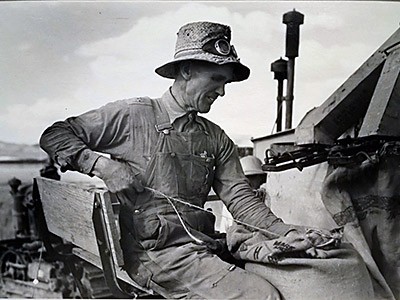Honors Students Curate Exhibit 'Growing West: Exploring Art & Agriculture'
Russell Lee, Mormon farmer who lives in Snowville, Utah, and who farms in Oneida County, Idaho, bagging wheat, 1940, gelatin silver print, 8" x 9.75”, Marie Eccles Caine Collection.
Utah State University’s Nora Eccles Harrison Museum of Art (NEHMA) opens “Growing West: Exploring Art and Agriculture” March 15-May 7, an exhibition organized by USU Honors in collaboration with NEHMA’s curatorial staff. The students’ work on the exhibit is part of a special Honors Think Thank course that focuses on sustainability in agriculture, food and land. An opening reception is Thursday, March 17, from 1-3 p.m. at the museum.
“Team taught by three of USU’s top professors, the Honors Think Tank is a unique citizen-scholar experience that focuses the Honors classroom on Cache Valley concerns,” said Kristine Miller, director of USU Honors program. “This year’s students are collaborating across disciplines to address local problems of food and water sustainability in creative ways.”
Sourcing objects from NEHMA’s collection ranging from photography to paintings, from ceramics to prints, the Honors students worked with the museum’s curatorial staff and their professor, Joyce Kinkead, to select artworks that recount the historical narrative driving Americans and European immigrants to settle the West as homesteaders and farmers. The exhibit also provides current perspectives on themes such as food production, gender roles, labor issues, irrigation systems and the mechanization of farming practices.
In addition to curating the exhibition, the students worked with NEHMA’s education staff to learn how to become docents; they will provide guided tours of the exhibition during the opening. The event is free and open to the public.
“The exhibition ‘Growing West’ is the visual realization of our readings in literature and history about how the west developed in terms of agriculture,” said Joyce Kinkead, professor of the Humanities/Arts section of the Honors Think Tank. “None of the students are experts at curating an art exhibit, but they have been intensely engaged in choosing the works, organizing them thematically and developing signage with guidance from an expert staff. NEHMA’s commitment to hands-on learning is exemplary.”
The 19th-century concept of Manifest Destiny led many of these individuals to settle in the West. Legislation such as the Homestead and Morrill Acts (1862) facilitated growth and established land-grant colleges like Utah State University to research practical applications of modern farming and engineering practices. “Growing West” illustrates the hardships that homesteaders faced such as the Dust Bowl and the Great Depression and the U.S. government’s efforts to provide relief and recovery through President Franklin Roosevelt’s groundbreaking New Deal programs. The Honors student curators invite viewers to consider the relationship with the agricultural industry’s past, present and future.
The artworks curated by the Honors students in the “Growing West” exhibition come from different times and places and ask viewers to consider the role of agriculture and sustainability in the present.
“As an academic art museum, NEHMA seeks to serve students and faculty across the university in their learning, specifically to find opportunities such as this where we expand their learning, challenge their approach to research and encourage cross-disciplinary connections in order to strengthen and broaden student’s skills no matter what major or discipline they are coming from,” said Katie Lee Koven, executive director and chief curator of USU’s Nora Eccles Harrison Museum of Art. “One way to understand how visual art can be relevant across disciplines is to first recognize that art is a reflection and sometimes a predictor, of us, of the artist, the place and the time.”
The Nora Eccles Harrison Museum of Art is dedicated to collecting and exhibiting modern and contemporary visual art to promote dialogue about ideas fundamental to contemporary society. NEHMA provides meaningful engagement with art from the 20th and 21st centuries to support the educational mission of Utah State University, in Logan, Utah. NEHMA offers complementary public programs such as lectures, panels, tours, concerts and symposia to serve the university and regional community. Admission is free and open to the public. Hours are Tuesday?Saturday from 10 a.m. to 5 p.m. and by appointment. Visit the NEHMA website for more information.
Related link:
Contact: Katie Lee Koven, 435-797-0164, katie.lee.coven@usu.edu
Comments and questions regarding this article may be directed to the contact person listed on this page.






